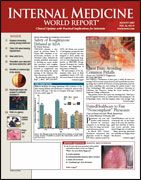Publication
Article
Internal Medicine World Report
Screen All Sexually Active Young Women for Chlamydial Infection
Author(s):
Revised Guidelines: The Evidence Doesn't Support Screening Men
By David S. MacDougall
Physicians are now expected to screen all sexually active young women (aged ≤24 years) who are not pregnant, as well as older women who are at increased risk and are not pregnant, for chlamydial infection, based on new practice guidelines issued by the US Preventive Services Task Force (USPSTF).
The new guidelines (Ann Intern Med. 2007;147:128-133) replace previous recommendations issued in 2001 and are based on the most recent (July 2000-July 2005) evidence published in English about screening asymptomatic persons.
Chlamydia trachomatis
is the most common sexually transmitted bacterial infection in young women in the United States, according to the Centers for Disease Control and Prevention (CDC). This infection can lead to a variety of serious conditions:
- Cervicitis
- Chronic pelvic pain in nonpregnant women
- Infertility
- Pelvic inflammatory disease
- Pregnancy problems: miscarriage, preterm labor, low birth weight, increased infant mortality
- Urethritis.
Nucleic acid amplification tests have high specificity for the identification of chlamydial infection in asymptomatic men and women, the USPSTF states. In populations with a low prevalence of chlamydial infection, a positive test result is more likely to be a false-positive than a true-positive finding.
Factors that increase the risk for chlamydial infection are:
- Being a sexually active young woman (aged ≤24), including an adolescent
- History of chlamydia or other sexually transmitted diseases (STDs)
- New or multiple sexual partners
- Inconsistent condom use
- Exchanging sex for money/drugs.
Increased incidence has been found in the following groups (of men and women):
- Incarcerated persons
- Military recruits
- Persons attending public STD clinics.
The prevalence of chlamydial infection varies widely among patient groups and is higher in African-American and Hispanic women than in the general population in many settings, the CDC says.
The optimal screening interval is unknown and is therefore not specified in the guidelines, although the CDC currently recommends at least annual screening for women at increased risk.
Screening for pregnant women at increased risk is recommended at the first prenatal visit, and those who remain at increased risk should be screened during the third trimester, the USPSTF says.
The current evidence is insufficient to determine the balance of the benefits and risks related to screening men for chlamydial infection. Specifically, the USPSTF did not find evidence that screening programs that target men result in a decreased incidence of infection in women.
All sexual partners of persons with chlamydial infection are recommended to be tested and treated if infected, or treated presumptively to prevent recurrent transmission.
Table. Screening for chlamydial infection
Routine screening is recommended for:
• Sexually active nonpregnant young women ≤24 years; older nonpregnant
women who are at increased risk
• Pregnant women ≤24 years; older pregnant women who are at increased risk
Routine screening is NOT recommended for:
• Men
• Women ≥25 years, pregnant or not, if not at increased risk
Source: Screening for chlamydial infection: US Preventive Services Task Force recommendation
statement. Ann Intern Med. 2007;147:128-133.





